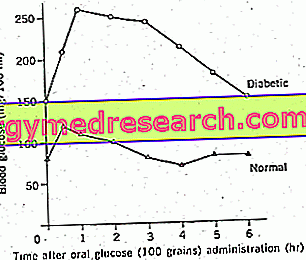OGTT is the acronym of Oral Glucose Tolerance Test, an Anglo-Saxon term Italianized in Test for oral loading of glucose .
Directions OGTT
The examination is performed for the diagnosis and screening of diabetes mellitus and glucid intolerance (IGT). This last condition is considered a pre-diabetic state, with the risk of evolution into overt diabetes in the years to come. The OGTT is performed, with due care, also for the diagnosis and screening of gestational diabetes and to monitor the glycemic effects of polycystic ovary syndrome.
The OGTT measures the ability of the body's cells to use glucose from the blood; glucose, or dextrose, is the sugar that is the main energy source of our body.
Contraindications OGTT
The test is contraindicated if fasting blood sugar exceeds 126 mg / dl, a condition that is already sufficient to diagnose diabetes. The same is true if random glucose values higher than 200 mg / dl are detected.
Preparation for the OGTT exam
Introduce yourself to the absolute fasting exam (only water is allowed) for at least 8 hours, without exceeding 14 hours. In the days preceding the test, follow a normally balanced diet, without excess calories or special preventions (alcohol should obviously be avoided); an intake of at least 150/200 grams of carbohydrates per day is recommended. Avoid strenuous physical effort in the two or three days before the test.
It is also very important the preventive suspension of any drugs interfering with the glucose metabolism (such as steroids), according to the advice of your doctor who must be warned for the exam (a few weeks).
OGTT execution
The exam takes place in the morning. The nurse performs a sample for basal blood glucose (fasting), then - if the measured value is less than 126 mg / dl - 75 g of glucose dissolved in 250-300 ml of water are taken, possibly in a short period of time. In the following hours the patient is invited to remain seated, without smoking or eating, possibly relaxed (emotional stress can distort the results). Blood glucose is measured at regular time intervals, usually after 30, 60, 90 and 120 minutes from ingestion of the first sip of glucose.


Nausea and vomiting, especially during pregnancy.
The exam is not painful; blood samples are taken as in any other normal blood test, so a puncture or a tingling can be felt at the time of collection. In subjects with coagulation problems it may be difficult to stop the small post-harvest bleeding. The blood volume taken as a whole is contained, so normally there are no problems (such as anemia) in this regard.
The aqueous solution of glucose has a very sweet taste.
OGTT interpretation
If after 120 minutes the glycaemia is between 140 and 199 mg / dl a diagnosis of glucid intolerance arises.
If after 120 minutes the blood sugar is ≥ 200mg / dl, diabetes mellitus is diagnosed.
| Glycemic levels | Normal | Altered blood sugar a fasting (IFG) | Altered tolerance glucose (IGT) | Diabetes mellitus (DM) | ||||
|---|---|---|---|---|---|---|---|---|
| Venous plasma | Fasting | 120 ' | Fasting | 120 ' | Fasting | 120 ' | Fasting | 120 ' |
| (Mg / dl) | <110 | <140 | > 110 * - <126 | <140 | <126 | > 140 <200 | > 126 | > 200 |
| (Mmol / l) | <6.1 | <7.8 | > 6.1 - <7.0 | <7.8 | <7.0 | > 7.8 | > 7.0 | > 11.1 |
1999 WHO Diabetes criteria - Interpretation of Oral Glucose Tolerance Test - OGTT
*> (100 mg / dl according to the ADA)
NOTES: the detection of glycaemia higher than 200 mg / dL after two hours of glucose loading indicates (if confirmed a second time) the presence of diabetes mellitus even if the fasting glucose is lower than 126 mg / dL.
The altered glucose tolerance is a condition to be constantly monitored, both for the possible evolution to diabetes mellitus, and for the greater cardiovascular risk compared to normoglycemic people. A similar discourse in the presence of impaired fasting blood glucose, a condition that is less worrying than the previous one.
OGTT variants
In pregnancy, for the search for gestational diabetes, oral minicar with 50g of glucose (GCT) and OGTT with 100g of glucose are used.



